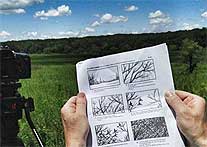From Billions to None: The Passenger Pigeon’s Flight to Extinction, reveals the compelling story of the unlikely extinction of the passenger pigeon and explores the pigeon’s striking relevance to conservation issues today, such as the alarming depletion of shark species worldwide. For centuries, the sleek long-distance flyer was the most abundant bird in North America and perhaps the world. It was hunted to extinction in a matter of decades. On September 1, 1914, Martha, the last passenger pigeon in captivity, died in the Cincinnati Zoo, marking the end of the species, and the upcoming centenary of the extinction event.
“The amazing story of how we eliminated this once abundant bird, coinciding with a centennial anniversary of its extinction, provides a once-in-a-lifetime “teachable moment” that can really raise awareness about species at risk and living more sustainably today.” says author and co-producer Joel Greenberg, A Feathered River Across the Sky: The Passenger Pigeon’s Flight to Extinction, (Bloomsbury USA, 2014), who is featured in the documentary. “Year 2014 is a real opportunity for conservationists, for all us.”
From Billions to None recreates the breathtaking natural phenomenon of massive flocks of passenger pigeons with cutting edge CGI animation. Created by talented students at the Tribeca Flashpoint Academy, Chicago, audiences can experience what it was like to stand beneath a surging flock of hundreds of millions of birds.
A key animated sequence recreates a passenger pigeon flock estimated to be at least one billion birds by a then unknown John James Audubon. In 1813, while traveling in Kentucky, Audubon wrote, “The air was literally filled with pigeons. The light of the noonday was obscured as by an eclipse. The pigeons passed in undiminished number, and continued to do so for three days.” The film’s sound designer had a particular challenge recreating the sound of many millions of birds; among the combined sound effects: a tornado, a herd of buffalo, an earthquake and an industrial dryer. In addition, remote control quadcopters equipped with small HD cameras captured astonishing aerials.
Other animation depicts bizarre hunting techniques, such as the use of a live decoy called a “stool pigeon,” the origin of the term, to lure unsuspecting birds to hidden nets. In the film Greenberg visits the preserved site of the largest passenger pigeon nesting in history in Wisconsin, a nesting area that equaled the size of 37 Manhattan Islands. During the 19th century the efficiency of railroad travel and telegraph communication enabled organized hunting of the birds for both food and sport shooting. By 1912, after a national search not a single bird could be found in the wild.
Marine Biologist Boris Worm of Dalhousie University, Nova Scotia, brings the story full circle, as technological advances have made pelagic fishing ruthlessly efficient. Worm highlights the alarming depletion of many shark species due to bycatch and for their fins, a key ingredient in shark fin soup. The documentary also briefly explores the De-Extinction movement and features an interview with Ben Novak, the young scientist who has been tasked by the Long Now Foundation to bring back the lost bird.
To mark the centennial of the bird’s extinction, From Billions to None was a key part of Project Passenger Pigeon, a group of over 160 cooperating institutions that mounted multi-media outreach initiatives throughout 2014, including the creation of a high school curriculum, down-loadable museum exhibits, and numerous activities across the United States and Canada. The documentary was distributed to public television stations nationwide for a September 2014 airing.
The film was financed through an Indiegogo crowdfunding campaign, as well as partial funding from the Illinois Arts Council Agency, the Rotman Family Charitable Gift Fund and the Wisconsin Society for Ornithology.
|




